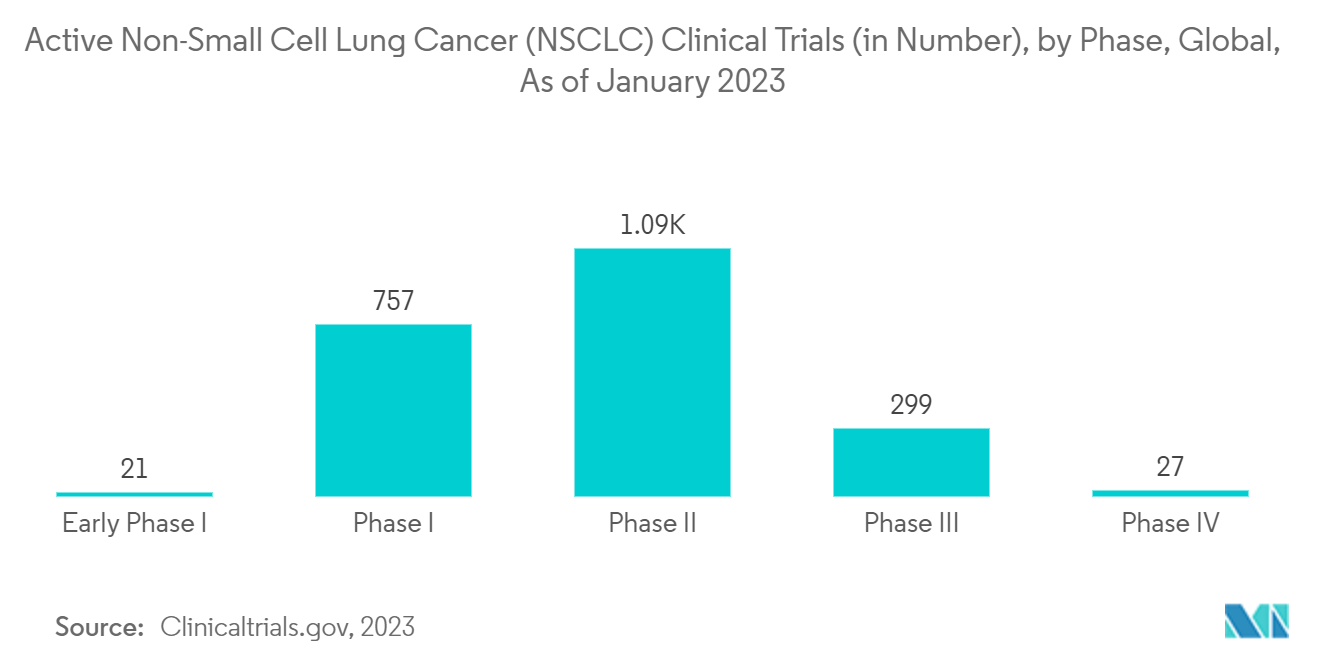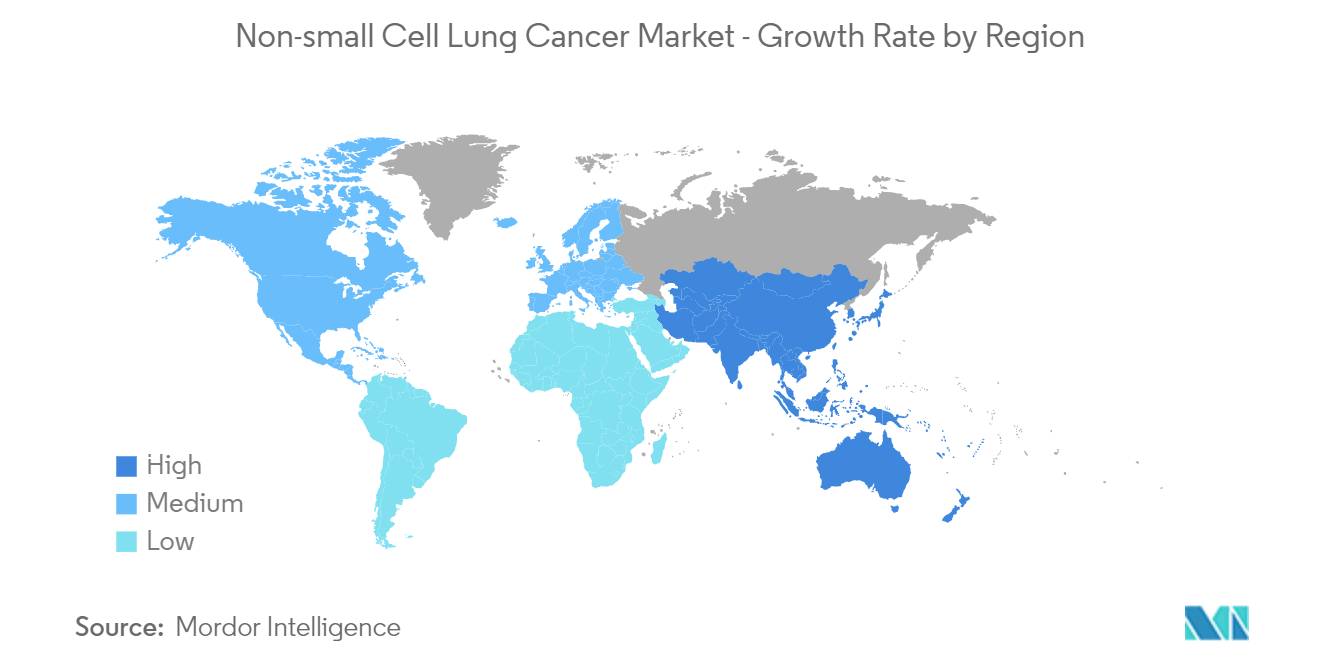Market Trends of Non-Small Cell Lung Cancer (NSCLC) Industry
Targeted Therapy Segment is Expected to Hold Significant Market Share Over the Forecast Period
The targeted drug therapy segment is anticipated to witness significant growth in the market over the forecast period owing to the factors such as the rising incidence of non-small cell lung cancer, and increasing company activities for developing novel treatments.
Targeted therapy drugs are often used to treat advanced lung cancers and are either used along with chemotherapy or used individually. Some of the major targeted therapy drugs to treat non-small cell lung cancer are Erlotinib (Tarceva), Gefitinib (Iressa), Afatinib (Gilotrif), Mobocertinib (Exkivity), Osimertinib (Tagrisso), and Dacomitinib (Vizimpro). These drugs targets mutated genes in the body and thereby avoid adverse effect on healthy cells. Investment by market players in the development of targeted therapy due to its advantages over standard chemotherapy and entry of these drugs in multiple countries across the world are likely to drive market growth. For instance, in October 2021, AUM Biosciences completed USD 27 million in a Series A funding round. These funds are used to advance the company's clinical-stage pipeline of precision and targeted cancer therapies.
According to an article published by MDPI, in December 2022, precision medicine's emergence has shed light on the treatment of non-small cell lung cancer, increasing the options available to patients with advanced NSCLC by targeting therapy on genetic and epigenetic markers. Additionally, as per an article published in the Journal of Hematology and Oncology, in June 2021, it has been observed that patients receiving targeted therapy showed a significant improvement in progression-free survival as compared to patients receiving chemotherapy. Also, as per the same source, for patients who underwent targeted therapy and had EGFR, ALK, ROS1, and BRAF mutations, the response rate ranged from 50% to 80%. Thus, the effectiveness of targeted drug therapy increases their adoption as well as demand for treating patients with NSCLC, hence propelling the segment growth.
Furthermore, the rising targeted therapy product approvals increase the availability of novel therapeutic drugs in the market which is also anticipated to augment the segment growth over the forecast period. For instance, in August 2022, AstraZeneca and Daiichi Sankyo's Enhertu, a targeted therapy, was approved in the United States for the treatment of adult patients with unresectable or metastatic non-small cell lung cancer whose tumors have activating HER2 (ERBB2) mutations. Also, in May 2021, the US FDA approved Rybrevant (amivantamab-vmjw) as the first targeted therapy treatment for adult patients with non-small cell lung cancer whose tumors have specific types of genetic mutations such as epidermal growth factor receptor (EGFR) exon 20 insertion mutations.
Therefore, owing to the factors such as the rising research activities by companies and institutions, growing adoption of targeted drug therapy treatment, and increasing product approvals, the studied segment is anticipated to grow over the forecast period.

North America is Expected to Have the Significant Market Share Over the Forecast Period
North America is expected to witness significant growth in the market over the forecast period owing to the factors such as the rising number of non-small cell lung cancer among the population and the presence of key players in the region focusing on launching and gaining approvals from the authorities. In addition, the increasing R&D investment by the players and huge healthcare spending in the region is also contributing to the market growth.
The increasing burden of NSCLC among the population is the key factor driving the market growth in the region. For instance, according to the 2023 statistics published by ACS, about 238,340 new cases of lung cancer are expected to be diagnosed in the United States in 2023. Additionally, as per 2022 statistics published by the Canadian Cancer Society, approximately 30,000 Canadians were diagnosed with lung and bronchus cancer, accounted for 13% of all new cancer cases, in Canada, in 2022. Thus, the high number of people suffering from lung cancer fuels the demand for effective treatment therapies such as chemotherapy, targeted therapy, and others. This is anticipated to propel the market growth over the forecast period.
Additionally, as per the data published by Statistics Canada, in January 2022, lung cancer is the most often diagnosed cancer and the leading cause of cancer-related deaths in Canada. About 50% of lung cancer cases are discovered at stage IV when the chance of survival is incredibly low (4% over five years). Thus, the high burden of lung cancer mainly discovered at the last stage increases the demand for chemotherapy sessions along with effective drugs, which in turn is expected to boost the market growth over the forecast period.
Furthermore, the growing company activities and increasing product approvals are also expected to increase the market growth over the forecast period. For instance, in August 2022, Health Canada approved Bristol Myers Squibb's OPDIVO 360 mg (injection for intravenous use) in combination with platinum-doublet chemotherapy every three weeks for three cycles for adult patients with resectable non-small cell lung cancer (NSCLC) in the neoadjuvant setting. Also, in January 2022, the US FDA granted Breakthrough Therapy Designation (BTD) to AbbVie's investigational telisotuzumab vedotin (Teliso-V) for the treatment of patients with advanced/metastatic epidermal growth factor receptor (EGFR) wild-type, nonsquamous non-small cell lung cancer (NSCLC) with high levels of c-Met overexpression whose disease has progressed on or after platinum-based therapy.
Therefore, due to the aforementioned factors, such as growing product approvals and product launches as well as the increasing number of non-small cell lung cancer cases, the studied market is expected to grow over the forecast period.

